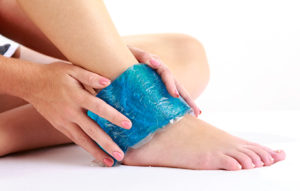Icing foot injuries, the well known “I” in R.I.C.E (rest, ice, compress, elevate) regime for treating acute sporting injuries has been used, as it has shown to reduce pain and believed to aid overall recovery.
There is no doubt icing for injuries helps to relieve pain, but does it really help with the overall healing of a soft tissue injury?
A influential article by Gabe Mirkin on the subject of the benefits of icing foot injuries and the implications it may cause has changed many practitioners ideas on icing foot injuries.
Practitioners have used my “RICE” guideline for decades, with the go to of rolling an ice bottle under your foot to treat heel pain. It appears that both ice and complete rest may delay healing, instead of helping”(Gabe Mirkin, MD, March 2014).
This has made many health practitioners incorporate more rehabilitation exercise and mechanical loading regimes for injured tissues. This is because these methods show positive effects over icing and rest for tissue healing. This is particularly true in tendon injures and plantar heel pain.
In the hierarchy of evidence functional rehabilitation, proprioception, balance, and range of motion (all tissue loading exercises) have a better rating than icing foot injuries when it comes to healing and recovery of tissues.
“Although cooling delayed swelling, it did not hasten recovery from this muscle damage” (The American Journal of Sports Medicine, June 2013).
Furthermore a summary of 22 scientific articles found almost no evidence that ice and compression hastened healing over the use of compression alone, although ice plus exercise may marginally help to heal ankle sprains (The American Journal of Sports Medicine, January, 2004;32(1):251-261).
What the evidence says about delaying healing by icing foot injuries:
When muscles and other tissues sustain an injury, your immunity sends inflammatory cells to the tissues to promote healing. This inflammation response allows the release of a hormone called Insulin-like growth Factor (IGF-1) into the area. This growth factor then helps muscles and other injured parts to heal. Applying ice to reduce swelling actually delays healing by preventing the body from releasing IGF-1(Gabe Mirkin, MD, March 2014).
Applying ice to injured tissue causes the blood vessels to constrict, reducing blood flow. This reduction in blood flow limits the amount of healing cells to the area. The blood vessels do not open again for many hours after ice therapy. Decreased blood flow for prolonged periods can cause tissue death and nerve damage (Knee Surg Sports, published online Feb 23, 2014).
Ice is often a short-term treatment to help injured athletes get back into a game. The cooling may help to decrease pain, but it interferes with the athlete’s strength, speed, endurance and coordination (Sports Med, Nov 28, 2011).
The authors discuss that if cooling is done to limit swelling, it should be for less than five minutes. This must be followed by progressive warming prior to returning to activity or sports.
Since applying ice to an injury reduces pain, it is acceptable to initially cool an injured part for short periods. You could apply the ice for up to 10 minutes, remove it for 20 minutes, and repeat 1-2 times. There is no reason to apply ice more than six hours after injured (Gabe Mirkin, MD, March 2014).
You can move and use the injured part as long as the movement does not increase the pain and discomfort. Get back to your sport as soon as you can do so without pain” (Gabe Mirkin, MD, March 2014).
Further Information about Icing Foot Injuries:
To read the full blog please click on the link below.
http://stoneathleticmedicine.com/2014/04/rice-the-end-of-an-ice-age/
At Well Heeled Podiatry we are trained and skilled in treating sporting injuries of the lower limbs and feet. We keep up to date with current evidence based practices to ensure our patients are getting the best treatment outcomes.










